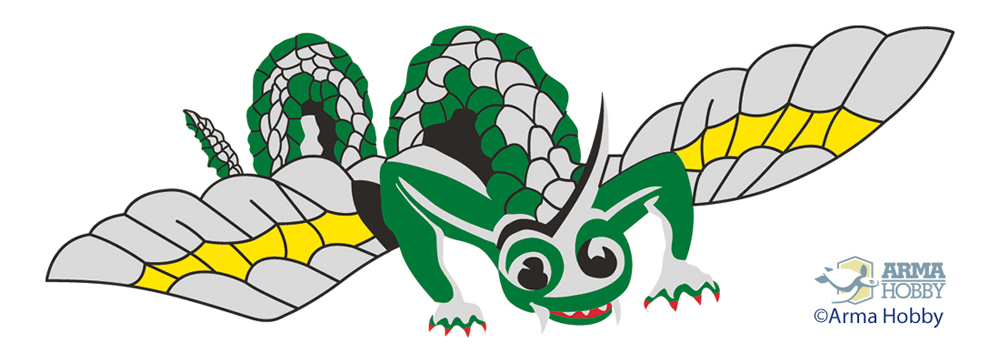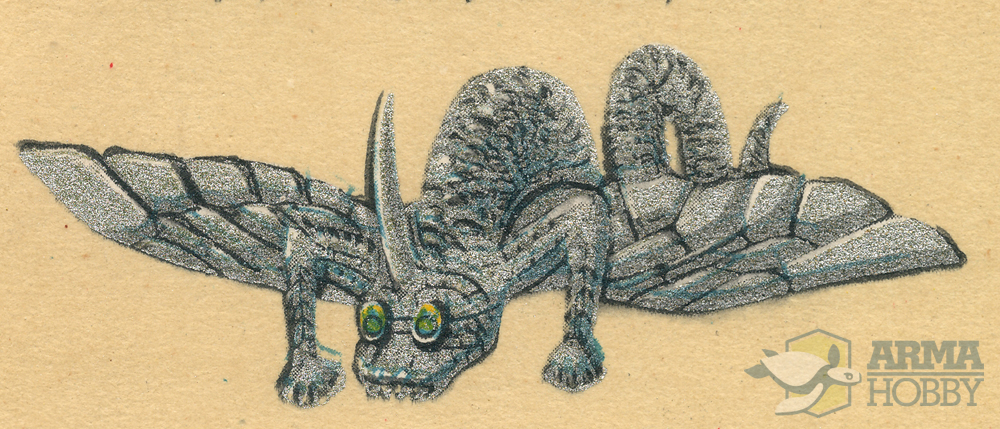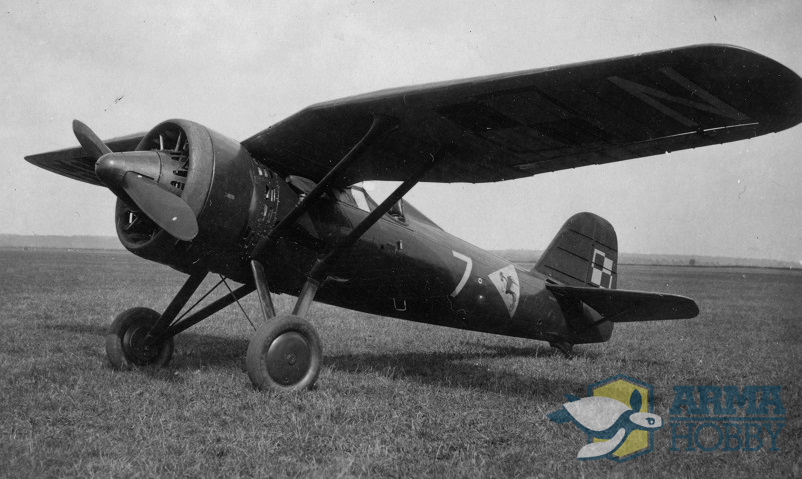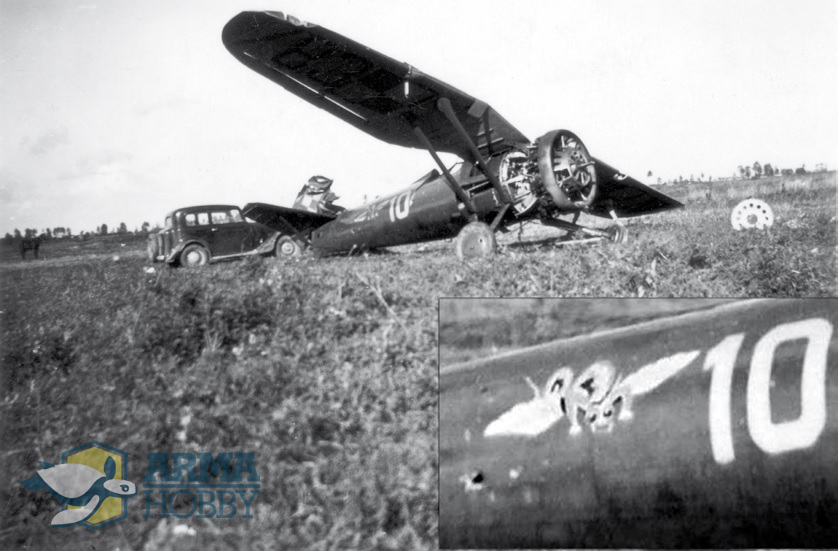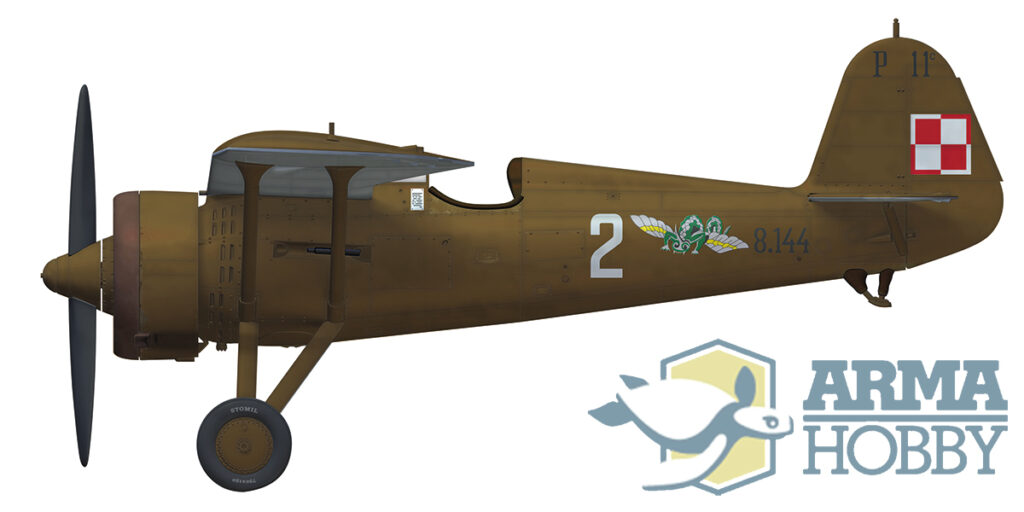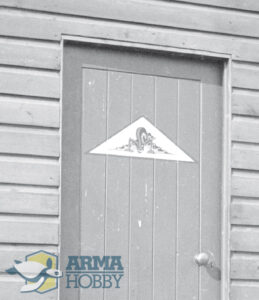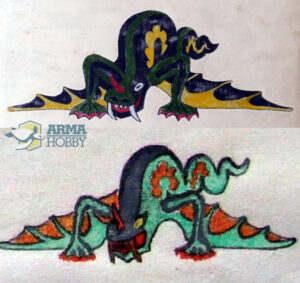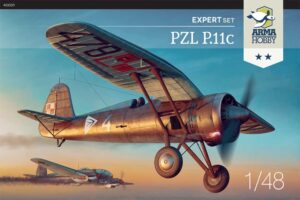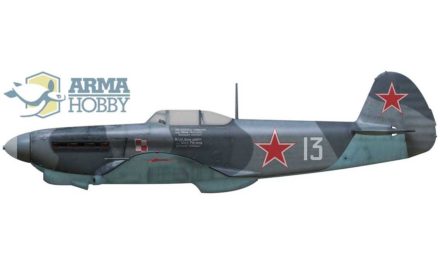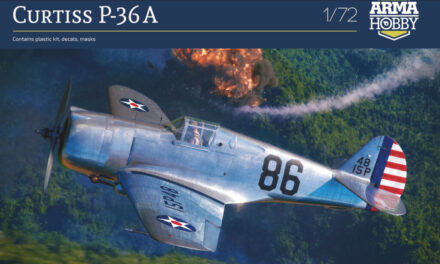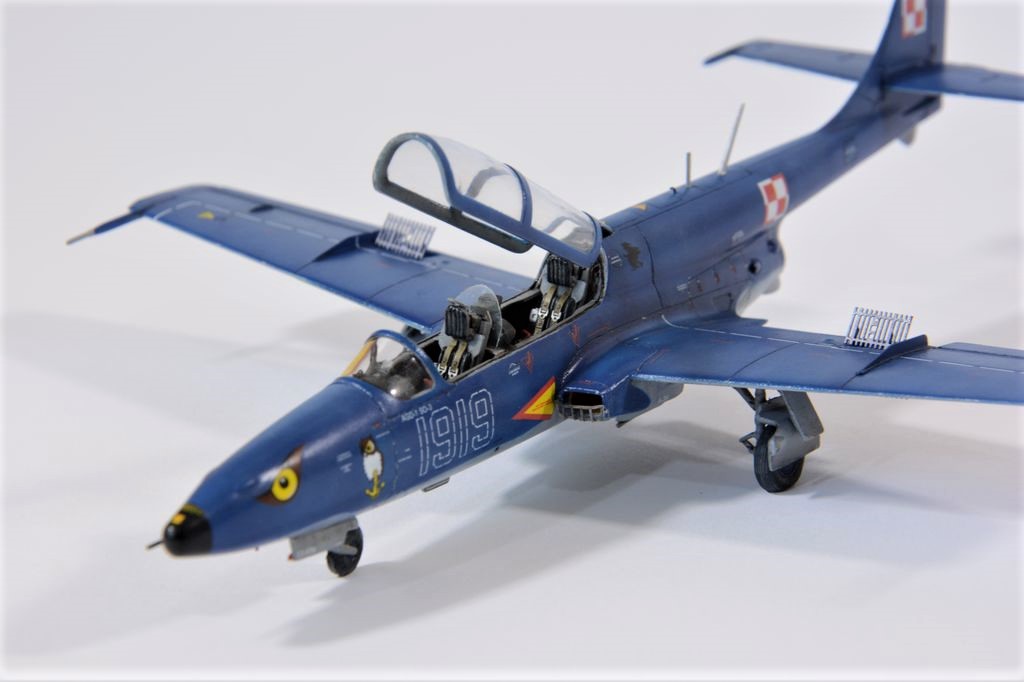Majority of Polish aviation fans would easily answer a question about the 112th Fighter Squadron insignia – the fighting rooster! But correct answer is not so obvious when we take a bit broader historical context into consideration and this requires some additional historical detective work.
Cover picture – 112th Fighter Squadron insignia in 1939r, reconstruction of colours made by the team: Zbyszek Malicki, Marek Rogusz and Grzegorz Mazurowski. Artwork by: Zbyszek Malicki.
The Polish 112th Fighter Squadron’s origins come from the French SPA 162 Escadrille (162 SPAD Escadrille), which used tiger’s head as its badge. This Escadrille came to Poland in May 1919 in process of repatriation of the Allied Polish Army in France led by General Józef Haller (so called ‘Blue Army’ or ‘Haller Army’). In August 1919 SPA 162 was re-organized into the Polish 19 Eskadra Lotnicza (19th Aviation Squadron) with F/Lt pilot Stefan Ciecierski as its first commander. In April 1920 it was renamed as 19 Eskadra Myśliwska (19th Fighter Squadron) and was moved to the Lithuanian-Byelorussian Front of Polish-Soviet war.
Among the first pilots performing this unit’s combat sorties were F/O Antoni Mroczkowski (then the unit commander), P/O Stefan Pawlikowski (he would became the commander of the Pursuit Brigade in 1939) and W/O Władysław Turowski. In 1920 the Squadron insignia was introduced: a winged reptile. This insignia has not been painted on the SPAD S.VII fighters used by the 19th Fighter Squadron. The metal badge was worn only on the airmen uniforms. After the end of hostilities the unit became part of the 1 Pułk Lotniczy (1st Aviation Regiment in Warsaw) and after following Air Force reorganizations it has finally been granted the ‘112’ designation in August 1928, which as 112th Eskadra Myśliwska retained till the end of the fights in September 1939.
Drawing of the badge of the 19th Fighter Squadron from the book “Ku czci poległych lotników” published in 1933 ( “In Honor of the Fallen Aviators”) – the metallic glow suggests that the image was made on the basis of a metal badge worn by airmen on the uniform. According to pre-war publication, this emblem was not painted on the aircraft of the 19th Fighter Squadron.
 The simplified, geometrical squadron insignia were introduced and used in Polish Air Force during the years 1928-1932. SPAD S.51C1 and SPAD S.61C1 fighters of the 112th Squadron were marked with two white horizontal bars on a red square background outlined in white. With introduction of the full metal PZL P.7a fighters in 1933 the allegoric squadron insignia have been reintroduced. The 112th Squadron got a new badge, designed according to the new rules: fighter squadrons adopted usually various birds images drawn on the geometric background (field), assigned to the particular Aviation Regiment (in 1st Aviation Regiment it was an equilateral triangle).Following this rules the 112th Squadron adopted the fighting rooster on a light-blue triangle background. Photographer Henryk Poddębski, made several photographs of 112th Squadron’s PZL P.11’s in the Okęcie airbase of 1st Aviation Regiment in May 1939. The 112th Squadron’s planes still have the fighting rooster badge painted on fuselage, despite the fact that at that time the 1st Aviation Regiment fighter planes were in the repainting process.
The simplified, geometrical squadron insignia were introduced and used in Polish Air Force during the years 1928-1932. SPAD S.51C1 and SPAD S.61C1 fighters of the 112th Squadron were marked with two white horizontal bars on a red square background outlined in white. With introduction of the full metal PZL P.7a fighters in 1933 the allegoric squadron insignia have been reintroduced. The 112th Squadron got a new badge, designed according to the new rules: fighter squadrons adopted usually various birds images drawn on the geometric background (field), assigned to the particular Aviation Regiment (in 1st Aviation Regiment it was an equilateral triangle).Following this rules the 112th Squadron adopted the fighting rooster on a light-blue triangle background. Photographer Henryk Poddębski, made several photographs of 112th Squadron’s PZL P.11’s in the Okęcie airbase of 1st Aviation Regiment in May 1939. The 112th Squadron’s planes still have the fighting rooster badge painted on fuselage, despite the fact that at that time the 1st Aviation Regiment fighter planes were in the repainting process.
Above: Geometrical badge of the 112th Fighter Squadron painted on Spad S.61C1 and Spad S.51C1 fighters and probably also on PWS-10 fighters in the period of 1928-1932.
112th Fighter Squadron received the new Polish full metal fighters PZL P.7a in 1933, and PZL P.11a fighters in 1935. These aircraft were adorned with allegoric squadron badges. The photo shows a PZL P.11a fighter with tactical number 7 with the emblem of the 112th Fighter Squadron – ‘the fighting rooster’. (M. Rogusz archive)
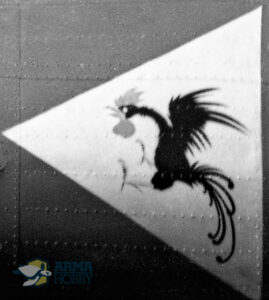 It was quite puzzling that there were no known photographs depicting PZL P.11 fighters adorned with the fighting rooster badge which were damaged or shot down during September 1939 campaign. Researchers managed to find photos of such rare polish aircrafts like PZL P.50 Jastrząb, PZL.46 Sum, PWS-35 Ogar, PWS-40 Junak and many more, but not a single aircraft with the fighting rooster badge… There were two likely possibilities: either the markings of 112th Squadron have been overpainted with camouflage paint (which in fact, was sometimes practiced in September 1939) or the 112th Squadron changed its badge.
It was quite puzzling that there were no known photographs depicting PZL P.11 fighters adorned with the fighting rooster badge which were damaged or shot down during September 1939 campaign. Researchers managed to find photos of such rare polish aircrafts like PZL P.50 Jastrząb, PZL.46 Sum, PWS-35 Ogar, PWS-40 Junak and many more, but not a single aircraft with the fighting rooster badge… There were two likely possibilities: either the markings of 112th Squadron have been overpainted with camouflage paint (which in fact, was sometimes practiced in September 1939) or the 112th Squadron changed its badge.
Left: The 112th Fighter Squadron badge painted on PZL P.11 fighter aircraft. (M. Rogusz archive)
Due to intensive research work including on-site verification it has been confirmed that the photo of PZL P.11a with the ‘7’ tactical number made by German soldiers in September 1939, has been taken on the edge of the park near the Zaborów Palace, where the 112th Squadron had its field quarters in September 1939. Was the ‘7’ really an aircraft from the 112th Squadron? This had to be confirmed.
The next puzzle piece was revealed with the discovery of another photo of PZL P.11a marked with ‘7’, showing partly obscured mysterious insignia: a bit like a dragon, a bit like a lizard or a gryphon… But this mysterious ’thing‘ was very similar to the badge painted on other PZL P.11a fighter, with the tactical number ’10’ which was photographed in September 1939. This insignia immediately reminds the historic 19th Fighter Squadron badge. And here comes another obvious association: G/Cpt Stefan Pawlikowski, commander of the Pursuit Brigade which 112th Squadron was a part of. G/Cpt Pawlikowski was a member of the initial personnel of the 19th Squadron in 1920.
PZL P.11a fighter aircraft with tactical no. 10, military serial no. 7.44, black underwing number (so called “police number”) 783-N. Aircraft with visible damage caused during capotage. The location of the aircraft was described variously as “near Warsaw”, Babice, Umiastów, a photograph taken by German soldiers in September 1939. On the fuselage one can see a bit blurred, but complete the new badge of the 112th Fighter Squadron, (M. Rogusz archive)
These discoveries immediately triggered another questions:
- Was this the new 112th Squadron badge, or maybe it has been painted on these two airplanes only, assuming they were formingthe unit’s staff section? Or
- Maybe it was a personal marking? But personal markings have not been used in Polish Air Forces for some years…
- How to call this ’thing‘, which was painted on these aircrafts?
- Why for so many years after the WWII nobody knew anything about this emblem?
“2” with Salamander, aeroplane flown by Lt. W. Łapkowski. Artwork by Zbyszek Malicki.
Soon, emerged another photo with a mysterious badge. This time it was PZL P.11c with marked with tactical number ‘2’. After conducting some research I have determined that this aircraft was most often flown by Lt. Wacław Łapkowski from the 112th Squadron. So it became apparent to me that these three airplanes could be reasonably attributed to the 112th Squadron. This was quite a firm argument reinforcing the hypothesis of the Squadron’s badge change.
I really needed some written historical sources in order to finally confirm this hypothesis. I have found it in the diary of famous Polish 303 Squadron formed in August 1940 in Britain.. Diary was cerated by P/O Mirosław Ferić and particularly a few pages of second volume of the diary, illustrated with drawing attributed to the 303 Squadron’s Flight ‘A’ commander F/Lt John Kent included the answers I needed. According to the Ferić’s notes to drawing: the 112th Squadron’s badge was “the salamander” shown on the picture! One can assume that Ferić, pilot of the neighboring Warsaw 111th Squadron knew very well how the creature has to be properly named and he documented that it was new badge of the 112th Squadron! Ferić’s notes and sketches in the diary have finally confirmed the hypothesis of the badge change! It is very interesting to note that while forming 303 (Polish) Squadron’s during the Battle of Britain, Polish pilots wanted the Flight ‘A’ to inherit the traditions of the 111th Eskadra Myśliwska, and the Flight ‘B’ traditions of the 112th Eskadra Myśliwska, what has been confirmed not only by squadrons diary but also by one of the photos from that period. Finally 303 (Polish) Squadron inherited Flight ‘A’ badge and the rest is history.
One of the pages of “Pilot’s Diary” by P/O Mirosław Ferić, diary later became an official chronicle of 303 (Polish) Fighter Squadron. Description accompanied drawing, made by P/O Ferić reads “Drawing made by F/Lt Kent, the commander of Flight ‘A’. (…) Based on the background of the Polish Air Force checkerboard, the badge of the Kosciuszko 111th Squadron and the ‘A’ letter of Flight ‘A’, on the right and at the bottom the Salamander – the badge of the Salamander 112th Squadron ( former Roosters squadron) and the ‘B’ letter of Flight ‘B’.” (archives of the Polish Institute and the Museum of General Sikorski in London)
There are still many mysteries to be solved:
- Where the idea of the 112 Eskadra’s badge change came from and who made the final decision?
- Was it formal decision, confirmed with proper military orders which were lost in human memory and a fog of war?
- When the new badges have been painted on the planes? (It is most probable that it happened immediately before the war outbreak.)
- Did they manage to paint the new badges on all the 112 Eskadra’s planes used in September 1939?
Photo above on the left: The door of Flight ‘B’ of 303 (Polish) Squadron adorned with the emblem of the 112th Fighter Squadron painted, RAF Northolt base in September 1940. (R. Gretzyngier archive)
Picture above on the Right: The Salamander badge, occurs twice in the chronicle of the 303rd (Polish) Fighter Squadron – the photo compares both appearances of this badge. Despite the differences in relation to the emblem visible in the photos from September 1939, the similarity and origin of the emblem do not raise any doubts. (archives of the Polish Institute and the Museum of General Sikorski in London)
Why, despite fact that the Salamander badge appears at least two times in the archive documents connected with the forming and first operations of the 303 Squadron, it disappeared from history of the Polish Air Forces? Was it too new, too complicated, or too exotic? Or maybe the Salamander was being used, but only memory about it has been lost?
I hope that someday we will find answers to these questions.
English Translation by Grzegorz Mazurowski
- Buy PZL model kits , including 40001 PZL P.11c Expert Set 1/48 with Salamander insignia, in Arma Hobby online store!
If you would like to know more:
- Marek Rogusz, Jakie było godło 112 Eskadry Myśliwskiej? –. „Gapa. Lotniczy Magazyn Historyczny”, 12, 2014, ss. 20–25.
- Łukasz Łydżba. Marek Rogusz. III/1 Dywizjon Myśliwski. Wyd. Vesper, Czerwonak 2015
- Polish Fighter Colours 1939-1947. Praca zbiorowa. MMP/ Stratus, Sandomierz 2016
Aeronautical engineer not working in his profession. History of Polish aviation 1918-1945 – its machines and people - is his greatest passion. Marek hunts for forgotten stories, helps to establish the fate of aviators and cooperates in Polish airplanes identification during archeological excavations. Author/co-author of many books and articles, incl. Polish Fighter Colours 1939-1947 vol. 1.
This post is also available in:
 polski
polski


